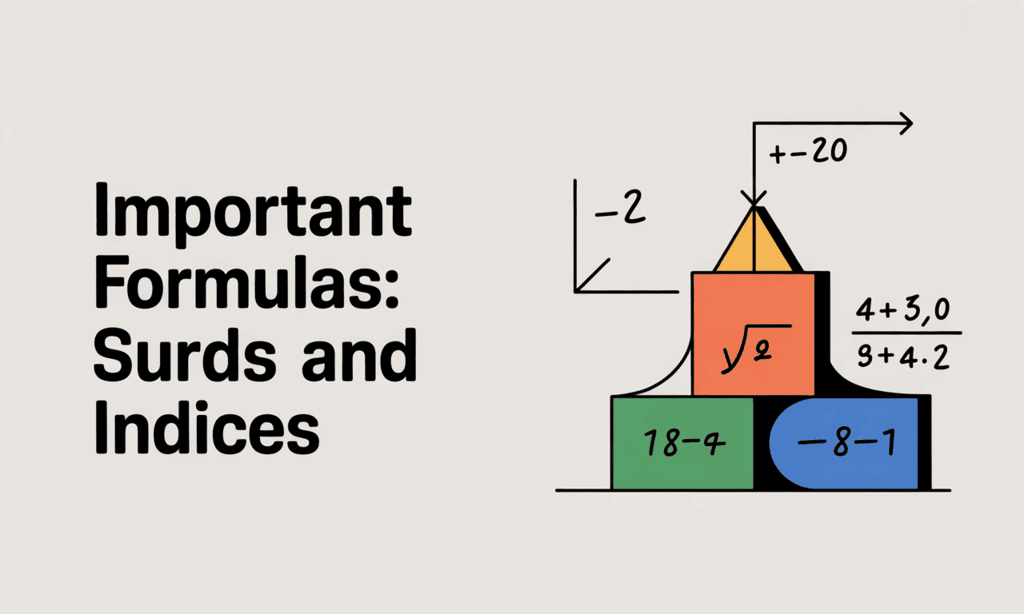Important Formulas: Surds and Indices | Quantitative Aptitude (Quant) - CAT PDF Download

Surds and Indices form a crucial part of the Quantitative Aptitude section in competitive exams. These concepts help simplify complex expressions involving powers, roots, and irrational numbers. Mastering the underlying rules allows you to solve problems involving exponents, equations, and simplifications with speed and accuracy.
Laws of Indices
Indices (or exponents) represent repeated multiplication of the same number. Understanding their rules helps simplify expressions quickly.
When the bases are the same:
- aᵐ × aⁿ = aᵐ⁺ⁿ (Product Rule)
- aᵐ ÷ aⁿ = aᵐ⁻ⁿ (Quotient Rule)
- (aᵐ)ⁿ = aᵐⁿ (Power of a Power Rule)
- (a × b)ᵐ = aᵐ × bᵐ (Product of Bases Rule)
- (a ÷ b)ᵐ = aᵐ ÷ bᵐ (Quotient of Bases Rule)
- a⁰ = 1 (Zero Exponent Rule, valid when a ≠ 0)
- a⁻ⁿ = 1 ÷ aⁿ (Negative Exponent Rule)
Fractional and Rational Indices
A fractional index represents a root. Converting between roots and exponents makes it easier to handle radical expressions.
- a¹⁄ⁿ = nᵗʰ root of a = ⁿ√a
- aᵐ⁄ⁿ = (ⁿ√a)ᵐ = ⁿ√(aᵐ)
Important Relationships
These relationships help solve equations involving exponents quickly:
- If aˣ = aʸ ⇒ x = y (valid when a > 0 and a ≠ 1)
- If aˣ = bˣ ⇒ a = b (valid when x ≠ 0; and both a and b are positive and real numbers)
Surds: Key Concepts
A surd is an irrational root of a rational number that cannot be simplified into a rational form.
Examples: √2, ³√7, √5, etc.
Two surds √a and √b are like surds if a = b (e.g., 3√2 and 5√2 are like surds).
They are unlike surds if a ≠ b (e.g., √2 and √3).
Surds are used to express non-terminating, non-repeating decimal values in an exact form.
Basic Operations on Surds
The same arithmetic rules apply to surds, provided the radicands (numbers inside the roots) are positive.
√a × √b = √(a × b)
√a ÷ √b = √(a ÷ b)
(√a)² = a
ⁿ√a × ⁿ√b = ⁿ√(a × b)
Example: √3 × √12 = √36 = 6
Rationalisation of Denominators
Rationalisation is the process of removing a surd from the denominator of a fraction. Multiply the numerator and denominator by the conjugate of the denominator.
Examples:
1 ÷ (√a + √b) = (√a − √b) ÷ (a − b)
1 ÷ (√a − √b) = (√a + √b) ÷ (a − b)
This helps convert irrational denominators into rational ones for simplification.
Shortcut Techniques
(a) Convert all exponential terms to a common base to simplify comparisons or equations.
(b) Factorise the number under a root to extract perfect squares and simplify the surd.
Example:
√72 = √(36 × 2) = 6√2
√50 = √(25 × 2) = 5√2
Therefore, √72 + √50 = (6 + 5)√2 = 11√2
These techniques help in reducing lengthy calculations in CAT questions.
Common Simplifications
Certain forms appear frequently and can be memorised for faster computation:
√(a²) = |a| (the result is always positive)
√(a²b²) = ab
√(a/b) = √a ÷ √b
If √a + √b = 0 ⇒ a = b = 0
EduRev Tip: Surds and Indices questions often test your ability to simplify expressions and compare powers efficiently. Focus on base conversions, rationalisation, and identifying patterns in powers and roots. Practice regularly to build speed and accuracy.
|
167 videos|229 docs|95 tests
|
FAQs on Important Formulas: Surds and Indices - Quantitative Aptitude (Quant) - CAT
| 1. What are the laws of indices and how do they apply in simplifying expressions? |  |
| 2. How do fractional and rational indices work in mathematical expressions? |  |
| 3. What are surds and why are they important in mathematics? |  |
| 4. How can I rationalize the denominator of a fraction involving surds? |  |
| 5. What are some shortcut techniques for simplifying expressions involving surds and indices? |  |















